The Sugarhouse
Keith Harris puts another log in the belly of the stove and closes the door. The room we are standing in quickly fills with steam as the evaporator begins to heat up. He steps back and leans against the wall, able to rest for a few moments. It’s an overcast day in Dayton, Maine, and we’re making maple syrup.
Limited to the northeastern corridor of the United States and Canada, the maple syrup harvest is a wholly North American experience. For folks growing up within the region, the beginning of the maple harvest is a sign that spring is just around the corner. The harvest requires a unique combination of cold nights and warm days for the sap to run, and when it begins you better hope you can keep up.
“There have been four generations making maple syrup on the farm since 1941 with Cody, my son, being the fourth,” Keith tells me. He carries himself as one well accustomed to his work. As we stand talking over the stove he moves to add logs every few minutes, always keeping an eye on the temperature gauges and sap levels in the tanks.
“We currently have around five hundred taps on land that the farm owns,” he continues, “and with my son interested in continuing to do this we’re looking at adding two or three hundred - maybe even five hundred more taps - that the farm is looking at buying.”
The sap runs rhythmically into the waiting buckets, as if nature created a natural metronome to mark spring’s advance. Maine’s maple syrup season can vary heavily year to year depending on the winter months. The earliest Harris Farms has tapped their trees was February 10th and the latest they ever tapped was the middle of March. Most years the season lasts five weeks and the sap will run twenty days within that window. During the day, starch stored in the roots for the winter rises through the trunk as sugary sap, allowing it to run off through the tap into the bucket. When the temperatures fall during the night the sap will reverse course and return back down to the roots, only rising again with the proper temperature. If the days remain cold or the nights do not fall below freezing the sap will not flow. As with most life on the farm, you can only lay the ground work required and hope the seasons work in your favor.
The day remains overcast but has warmed considerably from the overnight lows. We’re walking on snow through the maple grove behind the sugarhouse. Keith is driving the side-by-side with the large collection tank on the back. Cody is walking from tree to tree collecting the day’s sap. The harvest is methodical; each movement seems well practiced and they work as a team, jumping between the trees and moving the side-by-side towards the next grove. The sap as it comes out of the tree could be mistaken for water. Clear and odorless it tastes distinctly sweet, as if someone had stirred a spoonful of sugar into a glass of water. The rich coloring of the maple syrup will reveal itself once the majority water has evaporated and, through boiling, the sugar has caramelized. Keith’s niece joins in the work when she arrives home from school; it’s all hands on deck for this harvest.
“It was too cold last night,” Keith says while driving back to the sugarhouse. “The roots didn’t have a chance to thaw today so there wasn’t as much sap to collect.” He speaks matter of factly, no sense equivocating the day’s yield. Cody begins to pump the sap up to the holding tank under the eve of the roof while Keith heads inside to light the fire under the evaporator. It’s time to boil.
The day’s work is far from over. While the collection of the sap is fast-paced and active the boiling of the sap is slow and methodical. “The key is to keep a steady heat,” Keith says off hand as he gathers more logs from outside. “Too hot and you can burn the sugar.” When it is collected, the sap contains only 2-3% sugar content; by regulation pure maple syrup must contain between 66-68% sugar content. In order to separate the water from the sugar they must boil the sap, evaporating the extra water content to condense the sugar. For every forty gallons of sap collected from the trees, Keith will produce one gallon of pure maple syrup.
The landscape in Dayton, Maine, is rolling hills. Old farmhouses crowd the roadside and wide open fields stand behind them. Snow drifts push up against the asphalt and the ground is covered for the most part. Patches of dirt and grass can be found on the hillsides and under the western side of the maples. Harris Farm sits in a lull between two hills. The large red dairy barn stands out behind the house and the feed barn behind it. A field stretches a thousand yards behind these to the forest. A well-worn track in the snow leads to a fading stone wall at the top of the neighboring hill. Five grandfatherly maple trees stand proudly against it, the metallic tap buckets shining out across the field in the afternoon sun.
Across the brine stained asphalt road, the sugarhouse sits where the muddy gravel lot ends, backing up to a maple grove. Using timber harvested from the property, the post and beam interior is stained and aged from its 15 years of use. The sap evaporator sits to the right, at 10 feet long and 2 feet wide it commands the most space of the small building’s interior. The stove chimney stands through the roof and there’s a stack of wood by the back door. A PVC pipe runs across the roof from the upper holding tank into the first of the evaporation tanks. Gravity pulls the sap from the upper tank into the evaporator, and as the water evaporates the sugar is pulled farther along until it sits in the final chute as syrup.
“My grandfather, John Harris, bought the farm in 1941,” Keith tells me. We’re standing next to the evaporator watching the sap boil. The whole room is cast in a sugary cloud of steam; the walls 15 feet away fade against the white light leaking through the windows. Keith steps away and pushes the back door open a crack, drawing off some of the room’s heavy steam.
“He was milking cows and raising sweet corn to sell to the local stores,” he continues. “My father continued that operation until he wanted to retire and then my brother Clint took over the dairy side of the farm.”
The farm continues to operate as a dairy today, delivering its milk in glass jars to homes and local natural food stores. The farm also produces grass-fed beef and seasonal vegetables throughout the year. During the winter months, the nearly 600-acre farm opens 40 kilometers of cross country skiing trails that ramble through the forests and fields on the property.
Keith and his family took over the syrup operations nearly 30 years ago. Every spring he sets the taps and watches over the harvest. When he is not processing sap, local school groups will tour the facilities. He leads them through the work involved and shows them how the weather plays a vital role in this seasonal harvest. Keith teaches the students about conservation and all of the ways the farm operates to keep the land healthy and productive for years to come.
“Everything we do on the farm we try to mimic the best we can to what would happen in nature. Obviously, the trees are flowing sap in the spring of the year so we go out and tap the trees but being conscious of only putting in only a certain number of taps depending on the size of the tree so that the trees remain healthy and viable.”
Keith and his son, Cody, are in the final stages of the harvest now. In the room adjacent to the evaporator they are heating the sap for a final time before bottling. Sitting on a small stool, Cody watches the thermometer, and only when the syrup reaches 180 degrees does he begin. He is careful to fill each vessel methodically; it won’t do to spill this liquid gold. Placing the pint bottles on the table beside him, Keith screws the tops on and leans them on their sides, allowing them to cool and naturally seal. In a typical season Keith, with his son Cody, will produce between 120 and 150 gallons of maple syrup.
Harvesting maple syrup requires patience and old-fashioned tenacity. The seasons dictate your days and the sap waits for no man. After 31 years of harvesting and boiling sap, Keith has experienced the very best years and years where weather and wood frustrated his efforts. New Englanders look to spring as the long awaited season for warmth and celebration. In the Harris household and many others in this region, it is also the chance to harvest a valuable resource from the land they live on.
Written and photographed for Buffalo Jackson










